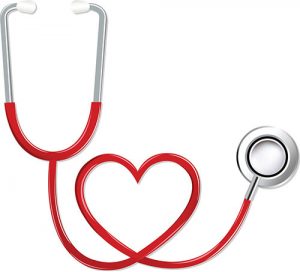 Several alumni wrote to share their front line or “front line adjacent” experiences in the medical field with COVID-19. Please note that some of these were written many months ago when the pandemic was just beginning to have its effects across the U.S. Responses continued to come in through the summer months and through the late fall. Situations were different in every time frame but the trauma and the unknown of the virus remain. When these were written, a vaccine was not yet released. No one knew when one might be. Some had time for only a few sentences; some found the time to share deeper thoughts. Thanks again to all who stand on the front lines — and adjacent to it — to do what they can to keep their fellow citizens safe.
Several alumni wrote to share their front line or “front line adjacent” experiences in the medical field with COVID-19. Please note that some of these were written many months ago when the pandemic was just beginning to have its effects across the U.S. Responses continued to come in through the summer months and through the late fall. Situations were different in every time frame but the trauma and the unknown of the virus remain. When these were written, a vaccine was not yet released. No one knew when one might be. Some had time for only a few sentences; some found the time to share deeper thoughts. Thanks again to all who stand on the front lines — and adjacent to it — to do what they can to keep their fellow citizens safe.
 Dr. Jeannine Hatt ’72
Dr. Jeannine Hatt ’72
Texoma Medical Center
Family Medicine Residency Program
Denison, Texas
Although I continue to be on staff on an ‘as needed’ basis at TexomaCare Pediatrics (TCP), I made the decision last year to step away from the busy practice. I remain an active staff member at Texoma Medical Center and participate as teaching faculty in the hospital’s Family Medicine Residency Program. My intention has been to give myself more opportunity for volunteering, to give better attention to committees and boards I serve on, to spend more time with my growing family, and, very importantly, I want to do my part in advocating for children here in Texas as well as globally.
The Pandemic’s Effects on Children
The pandemic hit as I was in this transition so has impacted my plans, and I have seen the effect it has had on TexomaCare and TMC. Research thus far has shown that young children are less likely to contract and become seriously ill with this strain of coronavirus, which for children is good news. However, pediatric offices had to consider the risks of bringing sick children into the office with potential exposure of well children. Routine well-child visits were limited and subsequently, TCP had to reduce work hours for staff. This put a burden financially on both out-patient practices, the hospital, and the many employees who have been furloughed or had their work hours cut, as well as delaying needed well-child care. More office visits are being conducted via telemedicine, which has the advantage of children and caretakers being able to receive some care without leaving home, but the risk of a decrease in quality of care.
Because of the risks of delaying routine immunizations in young children, priority was given to those ages 2 and younger. Well-baby visits were scheduled on a limited basis. TCP is presently catching up on well visits and vaccines for all children, including those 4 to 6 years, 11-12 years, and 16 years. But the pandemic has had a negative impact on children, both locally and globally, because many have still been missing the protection from diseases that vaccines provide. In certain populations, diseases such as whooping cough and measles pose a greater risk than the novel coronavirus. Most physicians in my age group have personally witnessed over the last 30-40 years the disappearance of diseases that once were commonplace in our practices, strictly because of vaccines. And, none of us want to see a return of those diseases.
In the meantime, pediatricians became increasingly concerned with the negative impact that social distancing and remote learning for students has had on children and adolescents. The harms from social isolation as well as the economic insecurities related to jobs lost has impacted the emotional and mental health of children and their families. Area mental health agencies have had an increase in calls with stories of struggles. In addition, many children in our area rely on school breakfasts and lunches. Not being in school puts children at nutritional risk. The negative and long lasting mental and physical health and educational impacts for our area’s and, actually, our world’s children are real.
In the times that I have been working at TMC the past few months, the precautions there have been intense with increasing employee fatigue. Of course, as with everyone, we all go through the screens with the list of questions and a temperature check each time we enter the clinic building or hospital. And, of course, masks and frequent handwashing are required for the entire time one is in the hospital. Lectures for the medical residents are all via Zoom, which makes interaction with the medical residents much less than ideal. I miss getting to see facial expressions and easily being able to respond to questions as most go into a chat box. And, of course, all committee and board meetings are via Zoom, impacting constructive interaction.
However, the low pediatric census in the hospital over the past months has illustrated how social distancing, masking, and hand washing do protect kids and their families from acquiring the common infections that can result in office visits and hospital admissions. Respiratory syncytial virus (RSV), which attacks so many young infants each year and sends many to the hospital, has not been seen these past months. Pneumonias, intestinal viruses, influenza, the complications of upper respiratory tract and skin infections, even asthma flares (commonly precipitated by respiratory viruses) are much rarer this ‘cold and flu season.’
 International Effects
International Effects
And, I have to include the terrible impact this pandemic has had on low income countries. Certainly, every country has had its struggles during this global health crisis. But it is those in the poorest countries who stand to suffer the most. The cost of preventing the spread of this disease, addressing outbreaks and caring for those who become severely ill has been difficult for everyone. However, the countries that chronically struggle to provide basic health services to their populations are quickly becoming overwhelmed.
Grace Children’s Hospital is located in one of the poorest areas of Haiti’s capital of Port-au-Prince, a country considered the poorest and with the highest child mortality rate in our hemisphere. Although the hospital’s range of services are broad and include adults as well as children, GCH is best known for its excellence in care of patients with tuberculosis, as well as other respiratory diseases, and HIV/AIDS. It is a hospital such as this that attracts patients suffering with the symptoms that are common with COVID-19.
The hospital has had to use more of its resources to purchase personal protective devices, has had to help support its staff and some families with food due to the economic impacts, have dealt with their doctors and healthcare workers becoming ill, and are needing more equipment such as oxygen concentrators which are expensive and difficult to access in Haiti. In spite of this, the hospital has continued to provide vital basic health services to hundreds of children and their families every week, including immunizations, nutrition screenings and management of malnutrition, perinatal and neonatal care, and other basic health services. Additionally, they provide educational sessions to staff and families while providing care in their very busy out-patient clinics for children and adults. But the economic impact of the pandemic has been threatening the hospital’s sustainability.
My husband, Dr. Chuck Phelps ’72, and I have provided support for this hospital for almost 20 years. We have carried in educational programs and medical equipment and supplies, usually visiting the hospital one to two times annually. It has been very sad and frustrating for us to have postponed several trips over the past couple of years, first because of civil unrest in the country and now, the pandemic.
We continue to provide support as we are able, which includes sharing our stories with supporters. We continue to promote the annual Race for Grace cycling group that has raised funds for Grace Children’s Hospital through rider sponsorships for the past 15 years. We have traditionally ridden as a team the last weekend of every year in the Hotter ’n Hell 100. But this year, our team had to participate ‘virtually.’ Fundraisers such as this, through which many nonprofits support domestic and global health needs, have felt the negative impact of this pandemic.
We are all grateful to the scientific community that feverishly worked to develop an effective and safe vaccine, that is now being rolled out. We physicians hope that the vaccine becomes quickly more easily available and, to ensure its success, that the public broadly agrees to take it. Making the vaccine available and accepted globally is probably the only way our world can hope to get back to some semblance of ‘normal.’
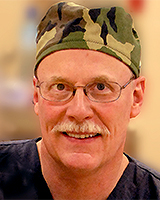 Dr. Larry Stewart ’75
Dr. Larry Stewart ’75
Oral & Maxillofacial Surgeon
Plano, Texas
I am a 1975 Austin College graduate and have practiced Oral & Maxillofacial Surgery in Plano, Texas, since 1982. Most of my work is office based as an ambulatory surgical center, but I still do cases in the hospital. My first exposure to any viral pandemic was during my training, when Hepatitis B, and then later what we called “Non-A, Non-B” (later to be called Hepatitis C) was raging. The rapid liver failure associated with a full-blown case of Hepatitis B was devastating to see in our patient population. Thankfully a vaccine followed several years later. About the same time, we began to have the first inklings of the HIV/AIDS pandemic. We were not sure exactly of the nature of the disease, but we knew that it was significant.
Not knowing how to protect yourself against these unseen invaders shaped my approach to practice. Since then we have gone on to experience SARS and MERS, so it has definitely made practicing a surgical specialty interesting. The COVID-19 situation has really eclipsed other issues, due to its infectivity and speed of spread.
When the mandatory shutdown occurred in March, we were some of the “necessary healthcare providers” that continued to see patients on emergent basis, and we continue to practice fulltime to this day. Since this has been an evolving situation with COVID-19, we have worked diligently to stay on top of the current CDC guidelines, some of which changed almost daily for a while, and still continue to evolve. Our biggest challenge currently is obtaining sufficient PPE to provide safe care for patients and to protect our staff. Thankfully because I’ve been in practice so many years, we have stable supply chains, but even those supply chains have been stressed by the number of new types of practices and even non-medical personnel who require PPE. It has driven the cost of delivering care up substantially!
One of my greatest joys in practice is getting to know my patients and something about them personally. Now having to wear full body PPE, an N95 respirator mask, with another barrier mask over it, and a face shield along with glasses, these physical barriers bring with them certain emotional/psychological barriers as well. I find myself really regretting this situation, because it seems that the ability to connect on a personal level is also hampered!
If my past experience serves as a guide, there will be at a point when we are able to move past the contagion portion of COVID-19, although I do believe that we will have this pandemic with us for quite some time. The thing that I treasure the most from my time at Austin College, is that the professors at Austin College took painstaking efforts to instill in us, how to think, reason and learn. Now, more than ever, we need rational and thoughtful voices in the national dialogue.
Dr. Charles Woodrow ’75
Mission Doctor and Director of Operations
Nampula, Mozambique
Over the past 20 years, the evangelical ministry, Grace Missions, has constructed a private charity surgical hospital in Nampula, Mozambique, which was on the verge of opening when the COVID-19 crisis emerged. In March 2020, the mission offered the facility to the government as a treatment center for the virus, and that offer was accepted.
While the Ministry of Health is officially responsible for running the hospital during this epidemic, due to its shortage of resources, the mission’s head doctor, Charles Woodrow, has been extensively involved in responding to the crisis. He has calculated epidemiology models, researched treatments and containment measures appropriate for the local context, designed reusable personal protective equipment, sourced medications and supplies locally and globally, designed an oxygen distribution system that includes tent infirmaries, supervised the construction of supportive infrastructure on the hospital’s premises, and held planning meetings with local health officials.
Thankfully the epidemic has so far been very mild in Mozambique, but preparations continue for treating a large number of COVID-19 patients, should that become necessary.
 Marlene Llopiz ’80
Marlene Llopiz ’80
Mexico City, Mexico
I had never been a part of any epidemiological/public health problem per se but had studied about it during my years as a student at Harvard University while working on my master’s degree in Public Health. This was certainly a hot topic for me, especially given I was living a very real and disastrous epidemiological event. Never in my wildest dreams did I expect to see how the world was crumbling and bowing to a virus so virulent and lethal we had no idea what hit us, the effect it would have and how long it would last. Basically – we had NO CLUE. It was faster than expected, more dangerous than ever imagined and gaining grounds quickly.
I´m based in Mexico City. I have practiced medicine for over 35 years. I have had my own practice, worked for several pharmaceutical companies, and carried out clinical research to bring new medications for diverse therapeutic indications into Mexico and Latin America.
At the beginning of the pandemic, no one ever thought it would hit so close to home. At first, we would hear stories about people infected—so distant from us that we never expected it to come anywhere near or affecting people we knew. Well, that changed in just a few weeks.
I´m not on the front lines, but I am contributing in several ways. I have come into contact (remotely and on the phone) with several friends— that´s how close this is to me now—who have tested positive for COVID-19. Not all of them have had symptoms—some have felt badly for a few days while others have been on the verge of death and in ICU for weeks on end.
During this time, a physician friend of mine and two psychologists started talking about the possibility of setting up a hotline for people to free their minds of fear, anxiety, frustration, anger, etc. We decided we would set up a support group for everyone who needed to be heard. We provide group and individual sessions to listen to friends, colleagues, and anyone who needs to be listened to. We speak about being scared of being infected, infecting others, and especially about dying and not seeing loved ones ever again. We have special guests such as physicians treating patients, COVID patients, family members, etc.
We hope to do some good considering that the pandemic has caused global social and economic disruption. It has led to postponement of many events worldwide, widespread supply shortages, as well as rampage purchasing. There have been changes in lifestyles, self-isolation, and social distancing. Our participation—although minor—helps in some degree to externalize and share common feelings of this difficult time period for all.
 Dr. Paul Spearman ’82
Dr. Paul Spearman ’82
Cincinnati Children’s Hospital
Infectious Diseases
Cincinnati, Ohio
I have been leading a division at Cincinnati Children’s Hospital that is actively working on combating the virus. As part of the NIH-sponsored VTEU network, we are deeply engaged in COVID-19 vaccine evaluation, and will be performing trials of multiple vaccine candidates through the summer and fall, and into 2021. We have rolled out a local serologic test to help with diagnosing the virus. In our laboratories, we are developing new vaccines and studying how the virus interacts with important immune cells. Basically, since this pandemic hit we have been working on many aspects of the virus and how to fight it.
Dr. Kathleen Rausch ’84
OB/GYN
MD FACOG
Reston, Virginia
Since the “shut down” from mid-March and ongoing, my biggest focus is trying to reassure my patients with what little science we do have. In that effort, it can be difficult and frustrating, because we do not have the proof from experience or time with this virus and its full effects on the developing fetus. So far, it does not appear to be as detrimental as other viruses humans have experienced in the world like measles, polio, HIV, or Zika as examples, but then again, we won’t know until time proves it to us.
My perspective is you can look at any situation as “the glass half full or half empty.” I am a perpetual optimist and until that glass is cracked, totally broken, and unable to hold any water, I will keep offering positive encouragement and hope. My patients (and probably all of us) really need that attitude, and I feel it is appreciated. In the meantime, wear your masks, wash your hands more often than not, be kind to all!! Focus on the positives.
Darren Levy DO ’86
Emergency Care Doctor
West Palm Beach, Florida
I’m an ER doctor in West Palm Beach, Florida, now an epicenter, doing an ER shift as I write! Yes, we’re seeing a lot of COVID patients. The experience is unlike anything we’ve ever seen! I have more to tell than I’m able to write. Working 4 nightshifts in a row.
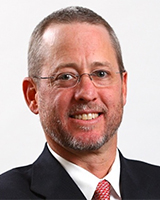
Dr. Byron H. Christie ’88
Chief of Staff
San Angelo Community Medical Center
San Angelo, Texas
I’m an interventional and diagnostic radiologist working for the world’s largest radiology practice called Radiology Partners. I lead a team of experienced radiologists who start new practices in hospitals where we’ve won a contract. Our team is tasked with integrating the Radiology Department into our group while also working clinically with direct patient care, especially during our interventional procedures. I became an airplane pilot to better accomplish the missions, allowing me to travel more efficiently.
I began a new project in Pensacola, Florida, in early February, and so I have been dealing with travel during the epidemic as well as living away from home as well. I also still work in my hometown of San Angelo, Texas, where I’m currently chief of staff for San Angelo Community Medical Center. Our medical executive committee has been much busier than normal due to COVID issues. My last week to be in Pensacola, I caught the dang virus and became symptomatic on my way home. After I recovered I was able to start work again, this time in South Carolina! I’m proud of all of my colleagues and the nurses and technologists and all the health care workers and facility caretakers who have all done their duty faithfully.
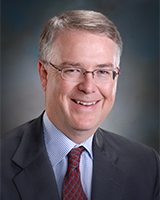 Dr. Mike Ragain ’88
Dr. Mike Ragain ’88
Chief Medical Officer
UMC Health Systems
Lubbock, Texas
My main work now is as chief medical officer of UMC, the primary teaching hospital for Texas Tech Health Sciences Center in Lubbock. My work with COVID has been around planning for how to handle the rise in patients and treat them effectively while protecting our staff from the infection—no small task with shortages of PPE. I am very proud of our team here in West Texas. We did indeed care for our patients very well and protected our staff in spite of supply shortages. Post exposure testing demonstrated a very low conversion rate for employees so what we were able to do worked. We also struggled to bring local testing capacity online in our lab due to shortages—same story for effective therapy for patients. At every turn our staff and medical staff innovated and solved problems. In many cases, they were “making brick without straw.” Alas, the struggle with COVID continues as we are now seeing higher numbers of cases in the community than ever.
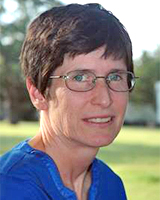 Laura McMeley, RN ’89
Laura McMeley, RN ’89
Clinical Informatics Coordinator
Tucson, Arizona
I am an RN, currently working in an acute care hospital in Tucson, Arizona. I do not work directly with patients. Rather, I am a clinical informatics coordinator. This means I support the electronic health system (EHR). During COVID-19 my team has been responsible for helping to equip those employees who could work from home, with the necessary tools to do so. We also have done a lot with testing computer equipment in units that are being opened to support the surge capacity in the hospital. We have been responsible for supporting education of staff around new features of the HER, which are being rapidly developed and deployed to help with COVID-19 care. We also are troubleshooting dashboards being designed to help the C-suite keep up with the needs of the hospital for supplies, staff, rooms, etc.
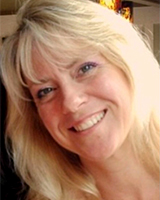 Dr. Dawn Bankston ’90
Dr. Dawn Bankston ’90
OB-GYN Robotic Surgeon
Plano, Texas
I am a 1990 graduate from Austin College and a 1994 graduate from UT Southwestern Medical School. I am an OB-Gyn/Robotic Surgeon in private practice since 1998 at Medical City Plano. My coronavirus experiences mostly involve keeping our mother-baby couplets safe while still attempting to provide safe prenatal care in the face of rising maternal morbidity statistics. The other side of the picture involves trying to triage our surgical patients who need their surgery sooner rather than later. Blood products are in low supply and PPE was critically low for the first six weeks. Would you believe that we as physicians were threatened with jail time if we operated on a patient who wasn’t deemed “emergent”? PPE shortages thankfully are improving and we are allowed to schedule surgeries again. I do have some private obstetrical patients who are currently infected by coronavirus and are sheltering in quarantine at home.
I have been involved in medical staff leadership including Chief of my department as well as escalating leadership roles all the way to Chief of Staff for Medical City Plano. My tenure in these roles wrapped up at the end of 2019. I do not have a stellar impactful personal story to relay but I will say that our real strength in medicine currently is in our wonderful nurses and allied health care support staff (respiratory therapists, PT/OT, environmental service workers , etc.) who deserve most of the recognition. They are by the patient’s bedside day and night. The pictures on TV of facial rashes from masks are real for these workers.
I do want to throw out the name of our current Chief of Staff. He is also an Austin College graduate and was appointed by me when I was Chief of Staff. His name is Brandon Meek, DO ’97 and he is an emergency medicine physician. He has been on the front lines both in the ER and administratively. He has been instrumental in policy making and procedural/protocol implementation for our campus. I believe our mortality rate is on the lower end of the spectrum due to our excellent ED and ICU.
I don’t have a big “front line” story … our practice is more of the daily grind … find PPE and keep our moms and babies cared for safely.
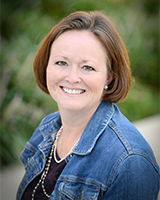 Dr. Autumn Dawn Galbreath ’93
Dr. Autumn Dawn Galbreath ’93
Internal Medicine
San Antonio, Texas
I work in urgent care, so throughout the pandemic we have been seeing people with COVID symptoms and doing COVID testing. I am in the San Antonio area, and initially, it was surprisingly slow. We did not see very many people with symptoms, and those we did see tended to be pretty sick. But, as the surge in cases occurred over the next few weeks, we could not see people fast enough. We have appointments available around the clock, and every single one of them fills up as soon as the next day’s appointments are released. It is busy and tiring. Seeing such large numbers of patients makes for long shifts and the worry about protecting myself and not taking infection home to my family is always present. I have had to add a variety of things to my regular routine, like changing clothes at work at the end of a shift and going straight to the washing machine and shower when I get home in order to eradicate any infection that might be on me or my clothing at the end of a shift. And, our staff members are the real heroes in the huge upswing and volume. They are triaging patients and doing swabs and answering the phone and generally keeping the total chaos as controlled as possible. They are amazing and I cannot imagine trying to practice without them.
A Battle Against Misinformation
Seeing all these patients, educating them, allaying their fears, and answering their questions is tiring. But, the much more difficult aspect of this pandemic for me has been the battle against misinformation. I have been truly baffled by the politicization of an infectious organism. I don’t know that I was naive enough to think the whole country would come together and battle this disease as one. But, I certainly did not expect the division, the conspiracy theories, the arguments, and the blatant spread of misinformation. I still don’t really understand why people peddle in untruth or why others are so quick to believe them. I have felt it was part of my professional duty as a physician to try to correct misinformation where it presented itself. But, this has proven a bigger challenge than I expected. There are people who are determined to believe what they have heard, even if the source from which they heard it is not a reputable one. I find myself especially exhausted by this aspect of the current situation. I think it is important for physicians and scientists to remain vocal in conversations and on social media and continue to promote correct information. But, every so often I have to take a day or two off because I just run out of steam!
Dr. Steve Odom ’95
Surgeon/ICU Doctor
Boston, Massachusetts
An Issue of Isolation
One striking issue is that of isolation. Patients were sick and dying alone as there was a strict no visitor policy, and this was difficult and worth talking about (though it is a bummer). There was also isolation of staff (physical as well as mental), in that it was unsafe to congregate, and Zoom is no substitute for human interaction (as I’m sure you’ve seen!). We also were trying to keep our families safe and it was quite lonely for all involved (healthcare workers and family members alike).
There was an incredible surge of activity and planning as state and local officials, and the hospital disaster response team put together a remarkable effort. We were able to accommodate hundreds of sick patients. For example, our ICU capacity went from around 60 beds to up to 300 beds within a week (the hospital only has 600 total beds).
Incidentally, resident and medical student education was drastically changed. Many people (nurses, respiratory techs, etc.) had to step out of their comfort zones to pitch in. For example, nurses from regular med-surg units were recruited into the ICU taking care of very, very sick people and did great things, over long hours, day after day!
We are also recruiting residents and fellows and this has all been done online which is weird and strange.
Michelle Shiller ’96
Pathologist
Baylor Scott and White
Dallas, Texas
I am a molecular genetic pathologist, and I helped lead the efforts to get diagnostic testing on board for Baylor Scott and White, primarily for the North Texas campuses. This was a collaborative effort, including who it would be offered to and how that would impact everything from resuming surgeries to patient discharge, patient location, employee testing, to name a few. I also used the opportunity to leverage social media to educate the community with ‘facts not fear,’ as one of my tag lines, which became widely embraced. I continue to do so, but at less frequent intervals. I was acknowledged by the healthcare system for my contributions with a picture of me as part of ‘the light pole project,’ where pictures of people instrumental to the efforts were taken and hung around Dallas.
Dr. Devin Trousdale ’96
Anesthesiologist and Pain Management
Dallas, Texas
I am an anesthesiologist at a teaching hospital. The thing that the public outside of healthcare does not see is just how completely transformed our hospitals are during this crisis. That has been going on since March. As a consequence, too many people are not getting routine care.
As an anesthesiologist who covers both general anesthesia and labor/delivery care, while I am exposed to COVID+ patients from time to time, I also realize my exposure is not nearly as bad as that of ER and ICU providers.
Also, if I could pass on one note of encouragement to readers, it would be that despite my contact with infected patients, my colleagues and I remain healthy, which leads me to conclude that while this disease can be transmitted easily, its spread seems to also be easy to prevent by practicing three habits: wear a mask, wash your hands, and maintain a safe (>6 feet) distance when possible.
Dr. Alen Michael
Anesthesiology Resident
Temple, Texas
I’m an anesthesia resident helping take care of the pregnant COVID patients and COVID+ emergent surgeries. It’s been a challenging time for everyone on the healthcare team, and even more so for the patients and their families. I consider myself blessed to be able to provide care for those in need, but at the same time would like to remind everyone the importance of social distancing. We are all in this together, and each of us can play an important role in keeping everyone safe.
Dr. Christina Castleberry Robinson ’00
General Pediatrics
Fort Worth, Texas
I am a pediatrician, and I practice in a mobile clinic to provide free medical services to children in Fort Worth. Since COVID-19, we quickly began virtual medical visits and developed a drive-through clinic for children’s regular, needed vaccines. Needless to say, these are things that I have never done before and never thought that I would do. However, they are accomplishing our goal of ensuring the children of Fort Worth have access to medical care.
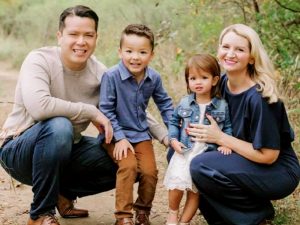 Dr. Angelo Vu ’00
Dr. Angelo Vu ’00
Internal Medicine
Fort Worth, Texas
I feel like my experiences during this pandemic are based in three distinct views. Obviously as a doctor that practices in a clinic, hospital, and nursing home, I knew COVID-19 was going to be a part of my daily existence. I did not fully realize the gravity of it all until we began trying to take care of these patients— without enough PPE, without tests, and without a treatment.
Everything we had been trained to do was now based around the hard truth that I couldn’t test everyone I needed to and even if they tested positive I had no clear plan for treatment. I found that what helped most was talking to the patients, both those suffering and those that were fine. Giving hope in a time that seems hopeless has always been something I felt I could do whether it was a patient battling cancer or today’s pandemic.
I also feel like I have seen the worst and the best of people during this time. I feel lucky because I had heard from friends and other medical people that they had been harassed for wearing scrubs after work getting groceries or for wearing masks. I had a guy come up to me when I was picking food up at Eatzis and start to just talk to me. Of course, after hearing colleagues get harassed I was worried for a second, but he told me he was unemployed and his wife was a bus driver but they were happy and healthy. He was super friendly and wanted to thank me for taking care of people (I was wearing my scrubs). A few minutes later I was checking out and I found out that the man had offered to buy my family’s dinner. I literally got to my car and cried. I think I cried because of the raw kindness (from a stranger who was unemployed) but also from the pent-up exhaustion of that week’s work.
I think my education starting at Austin College though med school and residency showed me that there are so many brilliant people that I have no doubt that we will beat this. I wish I could give the world that confidence I have since I have seen it firsthand. I have seen friends work together to literally save lives.
I have other thoughts including as a private owner of my medical practice this virus has taken that part of my life for a rollercoaster ride, too. My wife also has spent longer hours than I have in planning, meeting, and working for her school district trying to do what’s best for the kids and the teachers. I feel, as a medical doctor, there is a lot of publicity supporting me in the public but I feel like the education world needs just as much support at this time too.
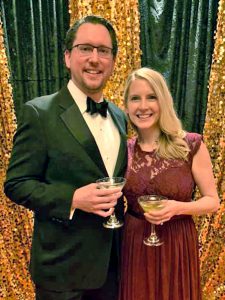 Dr. J. Russell Womble ’02
Dr. J. Russell Womble ’02
Internist
Norman, Oklahoma
For a bit of my background, I graduated from Austin College in 2002 and from Texas Tech School of Medicine in 2006. I then completed my residency in Internal Medicine from the University of Oklahoma in 2009. I have since been employed as a hospitalist at a smaller metro area hospital in Oklahoma. My wife got her nursing degree from Langston University, worked in the inpatient setting for a number of years, went back to school for her master’s degree, became a Nurse Practitioner, and has been working with me in the hospital for the last five years or so.
Probably like most, when I first heard about this new coronavirus in China back in December/January, I was not particularly concerned thinking the news we were getting was mostly exaggerated. As things began to worsen in Wuhan and cases started to pop up in Italy and Washington state, I still was not too worried but started keeping a closer eye. As soon as there were case reports of community spread and the stock market started dropping, my concern rose significantly. It was late February when I began to prepare my family with supplies such as long-term food, water, and sundries (toilet paper included). We also began to plan what we would do as a family were the virus to spread to our community, knowing that both my wife and I could be exposed.
The virus did eventually affect our community in a big way, such as causing almost 100 simultaneous infections at a nursing home close by our hospital resulting in 10 or so deaths, but also in a small way, by there just not really being that many cases requiring hospitalization. In fact, it was the quietest my hospital had been for close to a decade. They had stopped all elective procedures/surgeries so this cut down on the number of patients significantly, and we also noticed a lot of the normal patients we would see were not coming in either. I am not sure whether there were less serious illnesses during this time or if people were scared to come to the ER to seek help. I suspect it was more the latter, as the people that were coming into the ER admitted they would have come in sooner had they not been worried about COVID exposure. This was exemplified by a young man who came in for difficulty breathing and had been having chest pains for 2 weeks. He only survived a couple of hours after admission and through the workup process, we found he likely had a severe myocardial infarction, probably when his symptoms started 2 weeks prior. Had he come in sooner, almost certainly he could have been saved.
I thought the hospital did an admirable job overall with what resources we had. As with most hospitals, there was certainly a lack of adequate personal protection equipment. There were not enough COVID tests, and the ones we had took 4-5 days to get results. Every week, I would ask the infectious disease specialists which treatment we were using this week. Hydroxychloroquine that week, then steroids, then hydroxychloroquine, then back to steroids, etc. … There were often confusing messages and instructions from hospital administrators, but I thought, as a whole, everyone came together really well. The community organized caravans of well-wishers who came to visit and left colorful chalk drawings and hand-painted signs saying things like “real heroes.” The months of March, April, and May went fairly smoothly with only a small number of medical staff getting sick then the cases dried up and things seemed to be getting back to normal.
Then we arrived in June/July with the cases starting to pick up again. Each day a new record. Most of the metro area hospitals are full. No community caravans lately. No Blue Angel flyovers. The pretty signs hung up in the spring are now tattered. The chalk drawings have all faded and washed away with the rain. When I walk up in the morning and leave in the evening, I see the rows of cars of hospital staff where from the rearview mirrors, instead of fuzzy dice, I see dingy, old, single-use face masks hanging. The protective hoods we share in the hospital are stained with the makeup and sweat of the hundreds who have used the same one.
We mostly have more well-established treatment plans for COVID patients with a number of larger ongoing trials, so I’m hopeful for the future. The patients do not seem scared anymore, which is good and bad. Good in the sense they are coming in when they are sick. Bad in the sense that even with a city ordinance requiring face masks, it’s still hard to convince people to do it. All of us employed by the hospital have been wearing masks for so long we can now easily recognize each other from just our eyes (which is a lot harder to do than you would think—how many people could you recognize if all you could see was their eyes?). We all have permanent marks across the bridge of our noses from the pressure of the mask. Eventually there will be herd immunity and/or a vaccine and things will finally get back to normal. Until the next global pandemic where I doubt much will have changed and few lessons will have been learned.
 Dr. Kristen Waw ’03
Dr. Kristen Waw ’03
Pediatrician
Rockwall, Texas
I’m a pediatrician in Rockwall, Texas, where my husband and I are raising three sons. I’m a partner in a private pediatric practice where I have practiced for 10 years following medical school at UTMB Galveston and residency at Children’s Medical Center in Dallas. During the initial shut-down, we saw the lowest patient numbers the practice has seen since opening in 1987, but very few COVID cases. We had to adjust to doing sick visits via telemedicine and car visits while in full PPE. Well-child checks for children above 5 years old were canceled. We had to learn to reuse our precious PPE as we have chronically been in short supply.
Now that we are in summer and physicals are in full swing, we continue to screen patients, eliminate any time in the waiting room and see our sick patients via telemedicine, car visits, or at the end of the day when well patients are gone. We are now seeing COVID cases daily in children ranging from infants to teens. It is uncharted territory and we are doing our best to take care of newborns, see well-child checks, keep immunizations up to date, assess and care for mental health in kids, (which has been very much affected by this pandemic), care for children who are sick with typical childhood illnesses as well as diagnose and treat patients with COVID-19. We are trying hard to keep ourselves and our staff healthy so we can keep doing what we can to keep kids healthy. None of us want to contract COVID-19 and especially do not want to take it home to our own kids. We must keep vaccines up to date to avoid reemergence of other deadly diseases.
Every day is different and staying on top of the research is an ongoing challenge. We will get through this, and until we do, community doctors like myself are here to help any way we can.
 Dr. PJ Maslanka ’05
Dr. PJ Maslanka ’05
Hospitalist
Abilene, Texas
I am a hospitalist at Abilene Regional Medical Center. It would be safe to say I am on the front lines. I treat COVID-19 patients every day in the hospital. It is difficult work because I do not get to know my patients. They basically only get to see my eyes because the rest of me is covered. We have very minimal treatment options. The patients are sick and scared, and we have very few things to offer. It can be demoralizing. We are at the front end of an upswing in my community and there is very little appetite for mask wearing and social distancing. I would ask all to take this seriously. As a hospitalist, I get to see the worst of the disease, the most sick. It is serious and we are currently behind.
Ashley Koruthu Chennankara ’06
Optometrist
Dallas, Texas
I work as an optometrist in Dallas/Fort Worth, and was somewhat shocked when we were deemed one of the “non-essential providers” for the majority of quarantine/shelter-in-place. I never thought being in the medical field would mean I’d be on furlough, but now that our practice has opened back up, the rigorous new “routine” definitely takes its toll. No waiting rooms, only in your car (which is tough in Texas summer heat!) and the amount of PPE we wear—double masks and goggles that fog because we’re often within six inches of a patient’s face. Not to mention that now Tarrant and Dallas counties have made facial coverings mandatory in all public locations. I have other family members and friends who are more on the front lines, but hospital layoffs recently have also made them nervous.
 Dr. David Savage ’07
Dr. David Savage ’07
Resident Physician
La Jolla, California
I was working at Cleveland Clinic when COVID-19 struck. I was a resident physician in my second year of Internal Medicine training. The shutdown from the pandemic started at our hospital on Wednesday, March 11. Just a day afterward I was going to host Dr. Patrice Harris, the now past-president of the American Medical Association, on campus. This was abruptly canceled despite months of planning. All in-person conferences and classes were completely canceled, too. Residency courses were converted to Zoom. Our usually bustling resident clinic was suddenly conducted strictly via phone and video calls. The hospital visitor policy was changed to not allow visitors except in specific circumstances. The hospital contracted with Amish seamstresses in Northern Ohio to make 12,000 cloth masks in two days, and employees were required to wear these throughout the work day.
I felt the impact of the hospital’s policy changes. This was especially true in April 2020 when I was working on the in-patient oncology service at Cleveland Clinic. I cannot imagine how terrible it would be to have cancer, be admitted to the hospital for a treatment complication, and then not have a visitor of any kind. I made it a point during April to call every family daily to let them know how their loved one was doing. They were all very appreciative of the updates, but what touched me the most were the number of people who thanked me not just for the call, but for my courage in being at the hospital during the worst of the pandemic. This touched me immensely, and on days when I was especially tired and busy, it could catch me off guard and make me tearful. COVID-19’s social distancing rules also made me get creative with how families see their loved ones. Whenever I needed to do a “goals of care” conversation with a very sick patient, I would figure out a way to connect with the spouse or next-of-kin with video so that I could include him/her in the conversation. Many times, this was the first time my patient had seen his/her family in days, and this would often elicit tears of joy.
The ways we have adapted to COVID-19 remind me that central to all of our health are our family and friends. This is what has made social distancing so hard. We are social by nature and we do poorly without the community that supports us. It made me a better doctor and I’ll be more mindful of engaging with families in the care of their loved ones well after the present pandemic fades.
 Dr. Daniel A. Jackson ’10
Dr. Daniel A. Jackson ’10
Emergency Medicine
Dallas, Texas
I am currently working on the front lines in Emergency Medicine in 9 different hospitals in Dallas Metroplex. I am working in a few downtown facilities as well as several community hospitals all the way from Kaufman to Rockwall and Allen. COVID has brought, but training at Parkland Hospital (Dallas) prepared me well. I have added a lot of personal protective equipment to my typical uniform of scrubs and stethoscope to keep myself and my patients safe. The more recent stress of inundating our healthcare system here in Texas has been somewhat frustrating because at times, I think this situation could have been avoided with proper masking in the community. I love the hospitals I work at and the teams that I get to stand with on the front lines. Now, more than ever, our teams are leaning on each other for support and camaraderie. I am proud to help serve my community and hope everyone does their best to keep themselves and their loved ones safe.
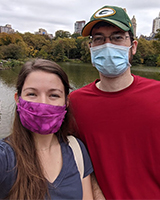 Libby Wise Janes ’15
Libby Wise Janes ’15
Social Worker
New York City, New York
My husband, Jesse Janes, was reassigned from his pediatric residency for four weeks into adult medicine to care for COVID patients, and I am the social worker for an adult Cardiology Unit that converted to a COVID-ICU.
I was initially on-unit as the first critical cases arrived, but converted to office-based across the street from the hospital after a week or so, when it became too dangerous for me to be on the unit, and when all of my patients became intubated anyway.
My unit, Kimmel Pavilion 15th Floor, became the ECMO unit for NYU Langone, providing the most intensive medical interventions for patients. My role was making heart-wrenching calls to families to plan for discharges for better or worse, providing emotional support to families who were isolated at home, and coordinating a wide variety of resources to families of my patients. Sometimes I worked hard to track down family members to become surrogate decision makers of patients who were so quickly intubated we had no known contact.
I identified NYC resources to help families access meals and advocated very hard to our IT department and supervisors to create space for families to record messages and share with bedside nurses to say, ‘I love you and goodbye’ to critically ill intubated patients. I had the privilege of witnessing and knowing their stories. I made too many condolence calls. I celebrated and cried with prayers of thanksgiving when I spoke on the phone with an ECMO recovered patient, a seemingly impossible recovery and a second chance for life, to encourage him to accept the special physical therapy rehab opportunity.
Through this trying time that demanded all I had to give, I summoned all the strength and resilience and compassion I had and gathered all possible support from Jesse, my mom, our families, Covenant Presbyterian Church in Lubbock, regular Skype with dear friends from Austin College, and a host of prayers from other friends, just to keep carrying on. I am deeply appreciative of their support, in awe of the medical efforts and successes of my colleagues at NYU Langone, and praying for the day when there will be zero new cases.
 Lauren Wheeler Hutton ’16
Lauren Wheeler Hutton ’16
RN Inpatient Care
Fargo, North Dakota
Since the onset of COVID-19, our hospital system has taken many steps to attempt to prevent the spread of the virus and keep people safe. There still is a dedicated unit for those patients in my hospital, where the staff is provided with hospital scrubs that they put on when they get to work and change out of when they leave. The amount of PPE needed can be daunting, but we have a responsibility as medical professionals to keep each other and the people we serve safe. I was floated up to that floor a couple times, but mostly I have been on my specific floor and helping others when the need arises.
We are required to wear paper face masks at all times and face shields in every patient room. Sometimes, it may seem tedious. However, I look at it and all the other social distancing measures (at first restricting any visitors and then limiting the number for patients, wearing a mask in public wherever I go, etc.) as necessary steps in keeping the community safe. Everywhere is affected by this virus, and we need to be proactive and work together to figure out more about it and fight it. It is rewarding to be an advocate for my patients during this crazy time when they may not have much support. I hope that we can make headway in this battle and work together to keep each other safe.


